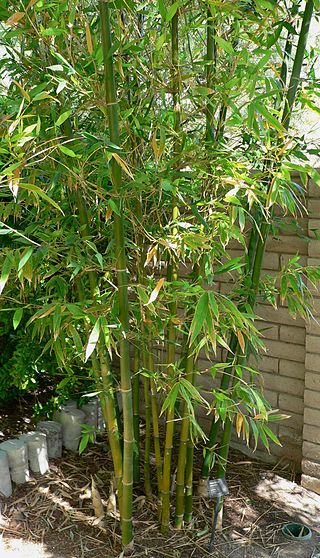
Bambusa is a large genus of clumping bamboos. Most species of Bambusa are rather large, with numerous branches emerging from the nodes, and one or two much larger than the rest. The branches can be as long as 11 m (35 ft).

Phyllostachys is a genus of Asian bamboo in the grass family. Many of the species are found in central and southern China, with a few species in northern Indochina and in the Himalayas. Some of the species have become naturalized in parts of Asia, South America, Australia, and southern Europe.
Apoclada is a genus of Brazilian bamboo in the grass family).

Phyllostachys aureosulcata, the yellow groove bamboo, is a species of bamboo native to the Zhejiang Province of China. It is a running bamboo with a distinctive yellow stripe in the culm groove that is often grown as an ornamental.

Ulmus uyematsuiHayata, commonly known as the Alishan elm, is endemic to forests at elevations of 800–2,500 metres (2,600–8,200 ft) in Alishan, Chiayi County, central Taiwan, where it is considered one of the minor tree species. The tree was first named and described by the Japanese botanist Bunzō Hayata in 1913, in the aftermath of the First Sino-Japanese War, when the Republic of Formosa was ceded to Japan.

Bambusa vulgaris, common bamboo, is an open-clump type bamboo species. It is native to Bangladesh, India, Sri Lanka, Southeast Asia, and to the province of Yunnan in southern China, but it has been widely cultivated in many other places and has become naturalized in several regions. Among bamboo species, it is one of the largest and most easily recognized.
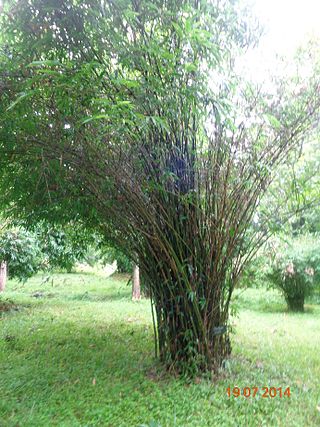
Bambusa tulda, or Indian timber bamboo, is considered to be one of the most useful of bamboo species. It is native to the Indian subcontinent, Indochina, Tibet, and Yunnan, and naturalized in Iraq, Puerto Rico, and parts of South America.

Bambusa lako, known as Timor black bamboo, is a large species of bamboo originating from the island of Timor; its black culms may reach 21 m (69 ft) in height. A 2000 molecular study places it as closely related to the similar Indonesian species Gigantochloa atroviolacea, from which it was separated in 1997; it may soon be placed in that genus. Bambusa lako can only be grown in climates that are mostly frost-free.

Bambusa spinosa, also known as B. blumeana, spiny bamboo or thorny bamboo, although in this respect it may be confused with Bambusa bambos, is a species of clumping bamboo occurring in Tropical Asia.
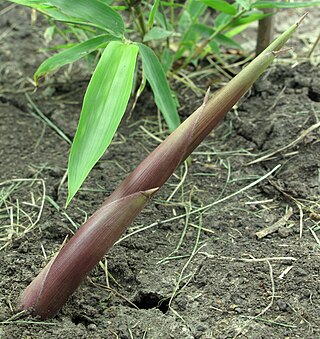
Phyllostachys parvifolia is a running bamboo with thick culms that grow tall for a bamboo that endures cold weather.

Bamboo shoots or bamboo sprouts are the edible shoots of many bamboo species including Bambusa vulgaris and Phyllostachys edulis. They are used as vegetables in numerous Asian dishes and broths. They are sold in various processed shapes and are available in fresh, dried, and canned versions.

Lepironia is a genus of the sedge family, comprising only one species, Lepironia articulata, known as the grey sedge. It is found in Madagascar, India, Sri Lanka, southern China, Southeast Asia, New Guinea, and various islands of the western Pacific. It also occurs in northern and eastern Australia, as far south as Thirlmere Lakes National Park in New South Wales.

Dioscorea japonica, known as East Asian mountain yam, yamaimo, or Japanese mountain yam, is a type of yam (Dioscorea) native to Japan, Korea, China, Taiwan, and Assam.

Sagittaria pygmaea, commonly known as the dwarf arrowhead or pygmy arrowhead, is an aquatic plant species. It is a perennial herb producing by means of stolons. Leaves are linear to slightly spatula-shaped, not lobed, up to 30 centimetres long.
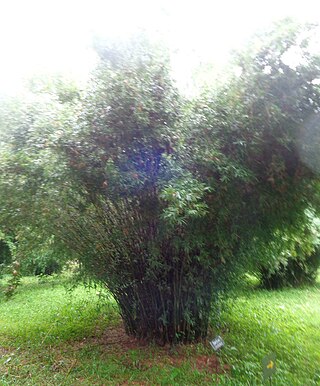
Bambusa multiplex is a species of bamboo native to China, Nepal, Bangladesh, Bhutan, India, Sri Lanka, Taiwan, and northern Indochina. It is also naturalized in Japan, Iraq, Madagascar, Mauritius, Seychelles, Pakistan, parts of South America, the West Indies, and the southeastern United States.
Bambusa barpatharica is a species of Bambusa bamboo.
Bambusa basihirsutoides is a species of Bambusa bamboo.

Bambusa beecheyana is a species of Bambusa bamboo.

Bambusa textilis, also known as slender bamboo, clumping bamboo and weaver's bamboo, is a species of bamboo in the Poaceae (grasses) family that is native to China. The subspecies var. gracilis is heavily cultivated in Australia.
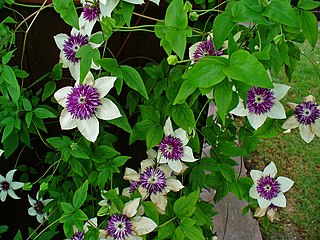
Clematis florida, the Asian virginsbower, or passion flower clematis, is a species of flowering plant in the family Ranunculaceae.

















